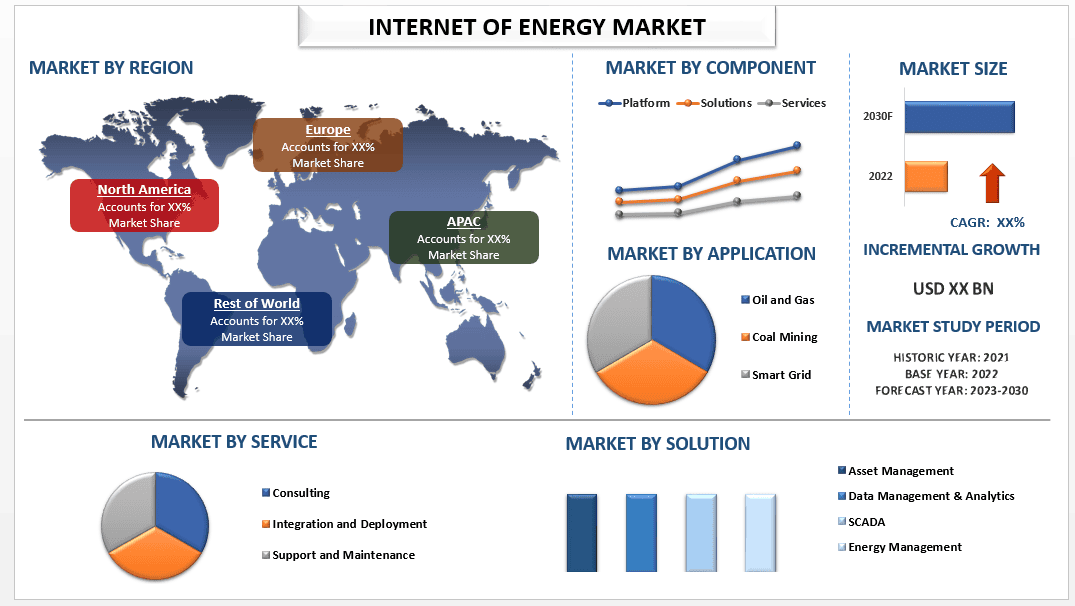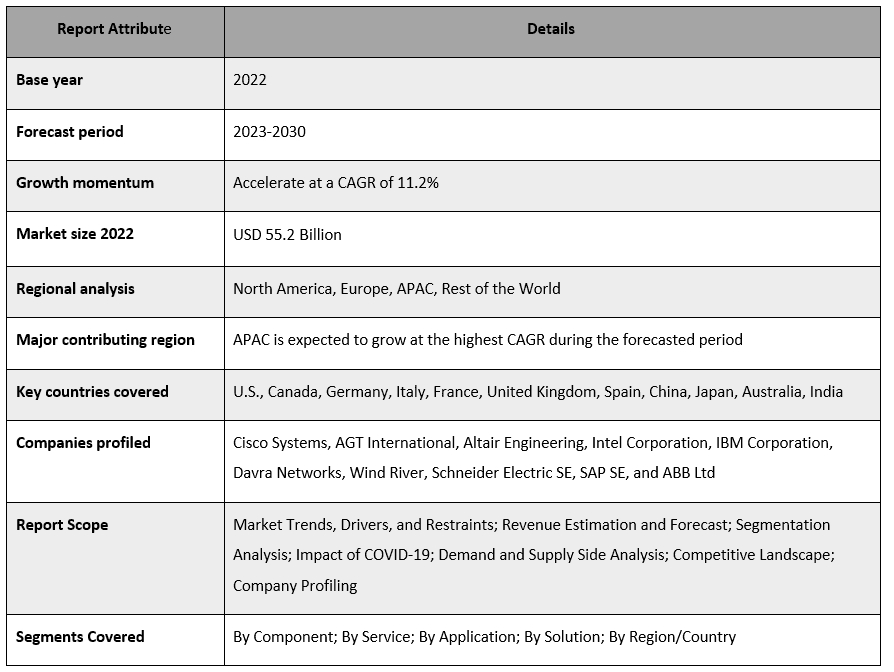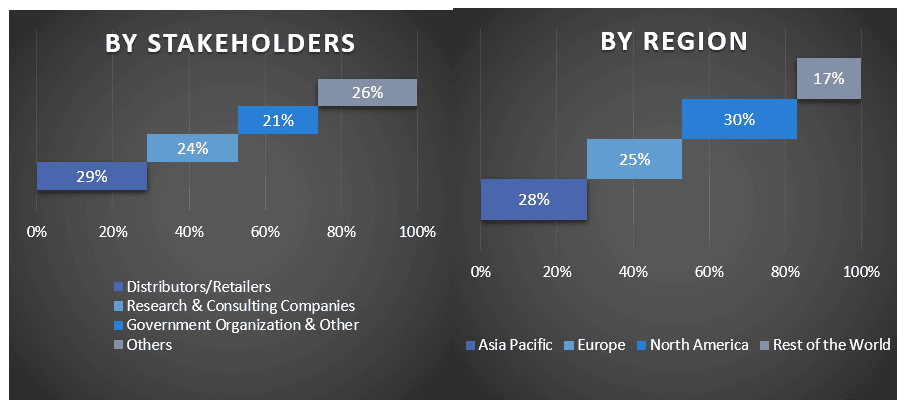- Startseite
- Über uns
- Industrie
- Dienstleistungen
- Lesen
- Kontaktieren Sie uns
Internet of Energy Markt: Aktuelle Analyse und Prognose (2023-2030)
Schwerpunkt auf Komponente (Plattform, Lösungen und Services); Service (Beratung, Integration und Bereitstellung sowie Support und Wartung); Anwendung (Öl und Gas, Kohlebergbau und Smart Grid); Lösung (Anlagenverwaltung, Datenmanagement & Analytics, SCADA und Energiemanagement); und Region/Land

Es wird erwartet, dass der Markt für das Internet der Energie im Prognosezeitraum (2023-2030) mit einer starken CAGR von 11,2 % wachsen wird. Dies ist hauptsächlich auf die Regierungsprogramme und Anreize zur Förderung saubererer erneuerbarer Energien und den steigenden Stromverbrauch weltweit zurückzuführen. Versorgungsunternehmen können das größte Potenzial daraus durch drei Mittel ausschöpfen: intelligente Zähler und das intelligente Netz, digitale Produktivitätstools für Mitarbeiter und die Automatisierung von Backoffice-Prozessen. IoT vereinfacht den Prozess der Energieüberwachung und des Energiemanagements und sorgt gleichzeitig für niedrige Kosten und ein hohes Maß an Präzision. Es adressiert alle Punkte des Verbrauchs eines Unternehmens über alle Geräte hinweg. Seine Analysetiefe und Kontrolle bieten Unternehmen ein starkes Mittel, um ihren Verbrauch zu verwalten, um Kosten zu senken und die Produktion zu optimieren. IoT-Systeme entdecken Energieprobleme auf die gleiche Weise wie funktionale Probleme in einem komplexen Geschäftsnetzwerk und bieten Lösungen.
Die von IoT gelieferten Analysen und Maßnahmen tragen auch dazu bei, die Systemzuverlässigkeit sicherzustellen. Über den Verbrauch hinaus verhindert IoT Systemüberlastungen oder -drosselungen. Es erkennt auch Bedrohungen für die Systemleistung und -stabilität, was vor Verlusten wie Ausfallzeiten, beschädigten Geräten und Verletzungen schützt. Beispielsweise nutzte die General Electric Company die IoE-Technologie und das Unternehmen startete ein eigenes Startup, das LEDs und Solarmodule mit Software kombinierte. GE kündigte Current an, ein erstes Energieunternehmen seiner Art, das die LED-, Solar-, Energiespeicher- und Elektrofahrzeuggeschäfte von General Electric mit seiner Industriestärke Predix-Plattform integriert, um die kostengünstigsten und effizientesten Energielösungen zu identifizieren und bereitzustellen, die von den Kunden benötigt werden. Dies ermöglicht es dem System, Daten zu sammeln, um Erkenntnisse auf Unternehmensabläufe anzuwenden, die darauf abzielen, Einsparungen in Bezug auf Beleuchtung und Produktivität zu erzielen.
Einige der wichtigsten Akteure auf dem Markt sind Cisco Systems, AGT International, Altair Engineering, Intel Corporation, IBM Corporation, Davra Networks, Wind River, Schneider Electric SE, SAP SE und ABB Ltd.
Mehrere Fusionen und Übernahmen sowie Partnerschaften wurden von diesen Akteuren eingegangen, um Kunden mit Hightech- und innovativen Produkten/Technologien zu unterstützen.
Im Bericht präsentierte Einblicke
„Unter den Komponenten hielt das Segment Solutions im Jahr 2022 einen dominierenden Marktanteil“
Basierend auf der Komponente ist der Markt für das Internet der Energie in die Segmente Plattform, Solutions und Services unterteilt. Das Lösungssegment erwarb einen Mehrheitsanteil am Markt für das Internet der Energie und wird im Prognosezeitraum voraussichtlich eine beträchtliche Wachstumsrate aufweisen. Das Internet der Dinge wird im Strom- und Energieerzeugungssektor stark implementiert. Das Lösungssegment unterstützt den Energiesektor bei der Energieerzeugung, Effizienz und Effektivität.
„Unter den Dienstleistungen hielt das Segment Integration und Bereitstellung im Jahr 2022 einen dominierenden Marktanteil“
Basierend auf der Dienstleistung ist der Markt für das Internet der Energie in die Segmente Beratung, Integration & Bereitstellung sowie Support & Wartung unterteilt. Das Segment Integration und Bereitstellung eroberte im Prognosezeitraum den größten Marktanteil auf dem Markt für das Internet der Energie, da die meisten Länder ihre Stromnetze entwickeln, modifizieren und aufrüsten, um mit dem zukünftigen Bedarf Schritt zu halten. Länder wie China und Indien tragen im Prognosezeitraum stark zum Wachstum des Marktes für das Internet der Energie bei, da sie massiv in die Entwicklung ihres Stromnetzes im prognostizierten Zeitraum investieren. China ist einer der größten Märkte für das Internet der Energie weltweit im Prognosezeitraum, aufgrund seiner kostengünstigen Produktionskapazität für intelligente Zähler und der Pläne, eine hohe Anzahl intelligenter Grid-Cluster zu entwickeln.
Internet of Things-Marktbericht – Abdeckung

„Unter den Anwendungen hielt das Segment Öl & Gas im Jahr 2022 einen dominierenden Marktanteil“
Basierend auf der Anwendung ist der Markt für das Internet der Energie in die Segmente Öl & Gas, Kohlebergbau und Smart Grid unterteilt. Das Segment Öl & Gas eroberte im Prognosezeitraum den größten Marktanteil auf dem Markt für das Internet der Energie. Öl & Gas ist das kapitalintensivste Segment auf dem Markt für das Internet der Energie, diese Energieunternehmen aktualisieren kontinuierlich ihre Softwaretechnologie und verbessern ihre Prozesse, um sich auf dem Markt zu behaupten. Die Implementierung des Internets der Energie hat diesen Unternehmen geholfen, ihren Gewinn zu erhalten und ihre Ölpreise zu senken. Diese IoT-Lösungen können für die Fernüberwachung auf Ölbohrinseln eingesetzt und die Pipeline-Integrität aufrechterhalten werden. IoT hilft bei der Fernüberwachung von Abläufen und End-to-End-Prozessen in Öl- und Gasanlagen, dies erkennt potenzielle Unfälle und führt zu einer höheren Effizienz.
„Unter den Lösungen wird erwartet, dass das Segment Energiemanagement im Prognosezeitraum mit einer signifikanten Rate auf dem Internet of Things-Markt wachsen wird“
Basierend auf den Lösungen ist der Markt für das Internet der Energie in die Segmente Asset Management, Datenmanagement & Analytics, SCADA und Energiemanagement unterteilt. Das Segment Energiemanagement würde im Prognosezeitraum mit einer signifikanten Rate auf dem Markt für das Internet der Energie wachsen. Die rasche Industrialisierung und Urbanisierung treiben den Markt für das Internet der Energie voran, und der wachsende Energieverbrauch aus Ländern wie Indien und China wirkt als Katalysator für das Wachstum des genannten Marktes. Bedenken hinsichtlich des Datenschutzes und der Datensicherheit behindern jedoch das Wachstum des Marktes in der Region.
„APAC dominierte den Internet of Things-Markt im Jahr 2022“
APAC verzeichnete den höchsten Marktanteil auf dem Markt für das Internet der Energie und wird im prognostizierten Zeitraum voraussichtlich eine einflussreiche CAGR verzeichnen. Dies ist hauptsächlich auf die Expansion und Modernisierung von Energieprojekten (einschließlich erneuerbarer Energien) zurückzuführen, die in China, Indien, Australien, Südkorea und Japan stattfinden. Darüber hinaus treiben günstige Regierungsrichtlinien, -vorschriften und -investitionen zur Erreichung der von verschiedenen Ländern festgelegten Ziele für erneuerbare Energien den Markt an. China hat sich aufgrund massiver Investitionen des State Grid im Norden und des China Southern Power Grid im Süden zum größten Akteur auf dem Markt für das Internet der Energie entwickelt. Die chinesische Regierung hat Ziele für den Anteil nicht-hydroelektrischer erneuerbarer Energien von bis zu 25,9 % im Jahr 2030 und 36,0 % im Jahr 2035 festgelegt und ihre gesamte installierte Kapazität von Wind- und Solarenergie bis 2030 auf über 1.200 GW erweitert. Massive Investitionen mit hohen Zielen für die Stromerzeugung werden im Prognosezeitraum als Katalysator für das Wachstum des APAC-Internet der Energiemarktes wirken.
Gründe für den Kauf dieses Berichts:
- Die Studie umfasst eine Marktdimensionierungs- und Prognoseanalyse, die von authentifizierten wichtigen Branchenexperten validiert wurde.
- Der Bericht bietet einen schnellen Überblick über die Gesamtleistung der Branche auf einen Blick.
- Der Bericht enthält eine detaillierte Analyse der wichtigsten Branchenkollegen mit einem primären Fokus auf wichtige Unternehmensfinanzen, Produktportfolios, Expansionsstrategien und die jüngsten Entwicklungen.
- Detaillierte Untersuchung von Treibern, Hemmnissen, wichtigen Trends und Chancen, die in der Branche vorherrschen.
- Die Studie deckt den Markt umfassend über verschiedene Segmente hinweg ab.
- Tiefgehende regionale Analyse der Branche.
Anpassungsoptionen:
Der globale Internet of Things-Markt kann je nach Anforderung oder einem anderen Marktsegment weiter angepasst werden. Darüber hinaus versteht UMI, dass Sie möglicherweise Ihre eigenen geschäftlichen Bedürfnisse haben. Nehmen Sie daher Kontakt mit uns auf, um einen Bericht zu erhalten, der Ihren Anforderungen vollständig entspricht.
Inhaltsverzeichnis
ForschungsMethodik für die Marktanalyse des Internets der Dinge (2023-2030)
Die Analyse des historischen Marktes, die Schätzung des aktuellen Marktes und die Prognose des zukünftigen Marktes für den globalen Markt des Internets der Dinge waren die drei Hauptschritte, die unternommen wurden, um die Einführung des Internets der Dinge in wichtigen Regionen weltweit zu erstellen und zu analysieren. Es wurde eine umfassende Sekundärforschung durchgeführt, um die historischen Marktzahlen zu erfassen und die aktuelle Marktgröße zu schätzen. Zweitens wurden zahlreiche Erkenntnisse und Annahmen berücksichtigt, um diese Erkenntnisse zu validieren. Darüber hinaus wurden ausführliche Primärinterviews mit Branchenexperten entlang der Wertschöpfungskette des globalen Marktes für das Internet der Dinge geführt. Nach der Annahme und Validierung der Marktzahlen durch Primärinterviews verwendeten wir einen Top-Down/Bottom-Up-Ansatz, um die vollständige Marktgröße zu prognostizieren. Danach wurden Methoden der Marktzerlegung und Datentriangulation angewendet, um die Marktgröße von Segmenten und Untersegmenten der Branche zu schätzen und zu analysieren. Eine detaillierte Methodik wird im Folgenden erläutert:
Analyse der historischen Marktgröße
Schritt 1: Detaillierte Untersuchung sekundärer Quellen:
Es wurde eine detaillierte Sekundärstudie durchgeführt, um die historische Marktgröße des Marktes für das Internet der Dinge aus unternehmensinternen Quellen wie Jahresberichten und Finanzberichten, Performance-Präsentationen, Pressemitteilungen usw. und externen Quellen wie Fachzeitschriften, Nachrichten und Artikeln, Regierungsveröffentlichungen, Wettbewerberveröffentlichungen, Branchenberichten, Datenbanken von Drittanbietern und anderen glaubwürdigen Veröffentlichungen zu erhalten.
Schritt 2: Marktsegmentierung:
Nachdem wir die historische Marktgröße des Marktes für das Internet der Dinge ermittelt hatten, führten wir eine detaillierte Sekundäranalyse durch, um historische Markteinblicke und Anteile für verschiedene Segmente und Untersegmente für wichtige Regionen zu sammeln. Die wichtigsten Segmente, die im Bericht enthalten sind, sind Komponenten, Dienstleistungen, Anwendungen und Lösungen. Darüber hinaus wurden Länderanalysen durchgeführt, um die allgemeine Akzeptanz von Testmodellen in dieser Region zu bewerten.
Schritt 3: Faktorenanalyse:
Nachdem wir die historische Marktgröße verschiedener Segmente und Untersegmente ermittelt hatten, führten wir eine detaillierte Faktorenanalyse durch, um die aktuelle Marktgröße des Marktes für das Internet der Dinge zu schätzen. Darüber hinaus führten wir eine Faktorenanalyse unter Verwendung abhängiger und unabhängiger Variablen wie Komponenten, Dienstleistungen, Anwendungen und Lösungen des Marktes für das Internet der Dinge durch. Es wurde eine gründliche Analyse für Nachfrage- und Angebotsseitenszenarien unter Berücksichtigung von Top-Partnerschaften, Fusionen und Übernahmen, Geschäftsausweitungen und Produkteinführungen im Bereich des Internets der Dinge auf der ganzen Welt durchgeführt.
Aktuelle Marktgrößenschätzung und -prognose
Aktuelle Marktgröße: Basierend auf den verwertbaren Erkenntnissen aus den obigen 3 Schritten ermittelten wir die aktuelle Marktgröße, die wichtigsten Akteure auf dem globalen Markt für das Internet der Dinge und die Marktanteile der Segmente. Alle erforderlichen prozentualen Anteile und Marktaufschlüsselungen wurden anhand des oben genannten sekundären Ansatzes ermittelt und durch Primärinterviews verifiziert.
Schätzung und Prognose: Für die Marktschätzung und -prognose wurden verschiedenen Faktoren Gewichte zugewiesen, darunter Treiber und Trends, Beschränkungen und Chancen, die den Stakeholdern zur Verfügung stehen. Nach der Analyse dieser Faktoren wurden relevante Prognosetechniken, d. h. der Top-Down/Bottom-Up-Ansatz, angewendet, um die Marktprognose für 2030 für verschiedene Segmente und Untersegmente in den wichtigsten Märkten weltweit zu erstellen. Die Forschungsmethodik, die zur Schätzung der Marktgröße angewendet wird, umfasst:
- Die Marktgröße der Branche in Bezug auf Umsatz (USD) und die Akzeptanzrate des Marktes für das Internet der Dinge in den wichtigsten Märkten im Inland
- Alle prozentualen Anteile, Aufteilungen und Aufschlüsselungen von Marktsegmenten und Untersegmenten
- Die wichtigsten Akteure auf dem globalen Markt für das Internet der Dinge in Bezug auf die angebotene Technologie. Außerdem die Wachstumsstrategien, die diese Akteure anwenden, um in dem schnell wachsenden Markt zu konkurrieren
Validierung der Marktgröße und des Marktanteils
Primärforschung: Es wurden ausführliche Interviews mit den wichtigsten Meinungsführern (Key Opinion Leaders, KOLs) geführt, darunter Führungskräfte der obersten Ebene (CXO/VPs, Vertriebsleiter, Marketingleiter, Betriebsleiter, Regionalleiter, Länderchef usw.) in den wichtigsten Regionen. Die Ergebnisse der Primärforschung wurden dann zusammengefasst, und es wurde eine statistische Analyse durchgeführt, um die aufgestellte Hypothese zu beweisen. Die Beiträge aus der Primärforschung wurden mit den Sekundärergebnissen zusammengeführt, wodurch Informationen in verwertbare Erkenntnisse umgewandelt wurden.
Aufteilung der primären Teilnehmer in verschiedene Regionen

Markt Engineering
Die Datentriangulationstechnik wurde eingesetzt, um die Gesamtmarktschätzung abzuschließen und genaue statistische Zahlen für jedes Segment und Untersegment des globalen Marktes für das Internet der Dinge zu erhalten. Die Daten wurden nach der Untersuchung verschiedener Parameter und Trends in den Bereichen Komponenten, Dienstleistungen, Anwendungen und Lösungen auf dem globalen Markt für das Internet der Dinge in mehrere Segmente und Untersegmente aufgeteilt.
Das Hauptziel der Globalen Internet of Things Marktstudie
Die aktuellen und zukünftigen Markttrends des globalen Marktes für das Internet der Dinge wurden in der Studie genau bestimmt. Investoren können strategische Einblicke gewinnen, um ihre Entscheidungen für Investitionen auf der Grundlage der qualitativen und quantitativen Analyse in der Studie zu treffen. Aktuelle und zukünftige Markttrends bestimmten die Gesamtattraktivität des Marktes auf regionaler Ebene und boten den Industrieteilnehmern eine Plattform, um den unerschlossenen Markt zu nutzen und von einem First-Mover-Vorteil zu profitieren. Weitere quantitative Ziele der Studien sind:
- Analyse der aktuellen und prognostizierten Marktgröße des Marktes für das Internet der Dinge in Bezug auf den Wert (USD). Außerdem Analyse der aktuellen und prognostizierten Marktgröße verschiedener Segmente und Untersegmente
- Die Segmente in der Studie umfassen die Bereiche Komponenten, Dienstleistungen, Anwendungen und Lösungen.
- Definition und Analyse des regulatorischen Rahmens für die Internet of Things-Industrie
- Analyse der Wertschöpfungskette unter Einbeziehung verschiedener Vermittler sowie Analyse des Kunden- und Wettbewerberverhaltens der Branche
- Analyse der aktuellen und prognostizierten Marktgröße des Marktes für das Internet der Dinge für die wichtigsten Regionen
- Zu den wichtigsten Ländern der in dem Bericht untersuchten Regionen gehören Asien-Pazifik, Europa, Nordamerika und der Rest der Welt.
- Unternehmensprofile des Marktes für das Internet der Dinge und die Wachstumsstrategien, die von den Marktteilnehmern angewendet werden, um sich in dem schnell wachsenden Markt zu behaupten
- Tiefgehende regionale Analyse der Branche
Verwandt Berichte
Kunden, die diesen Artikel gekauft haben, kauften auch










